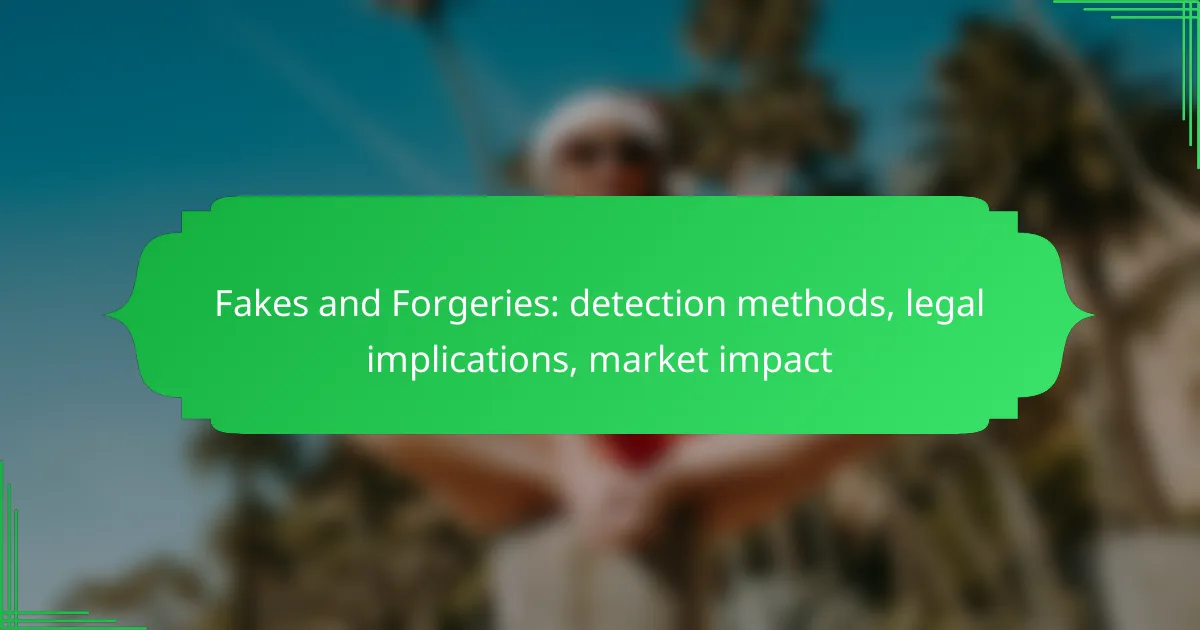Fakes and forgeries pose significant challenges across various markets, necessitating effective detection methods that range from basic visual inspections to sophisticated technological solutions. The legal implications in the UK highlight the importance of protecting intellectual property and consumer rights, with serious consequences for those involved in counterfeiting. Additionally, the presence of counterfeit goods disrupts market dynamics, leading to financial losses and diminished consumer trust.
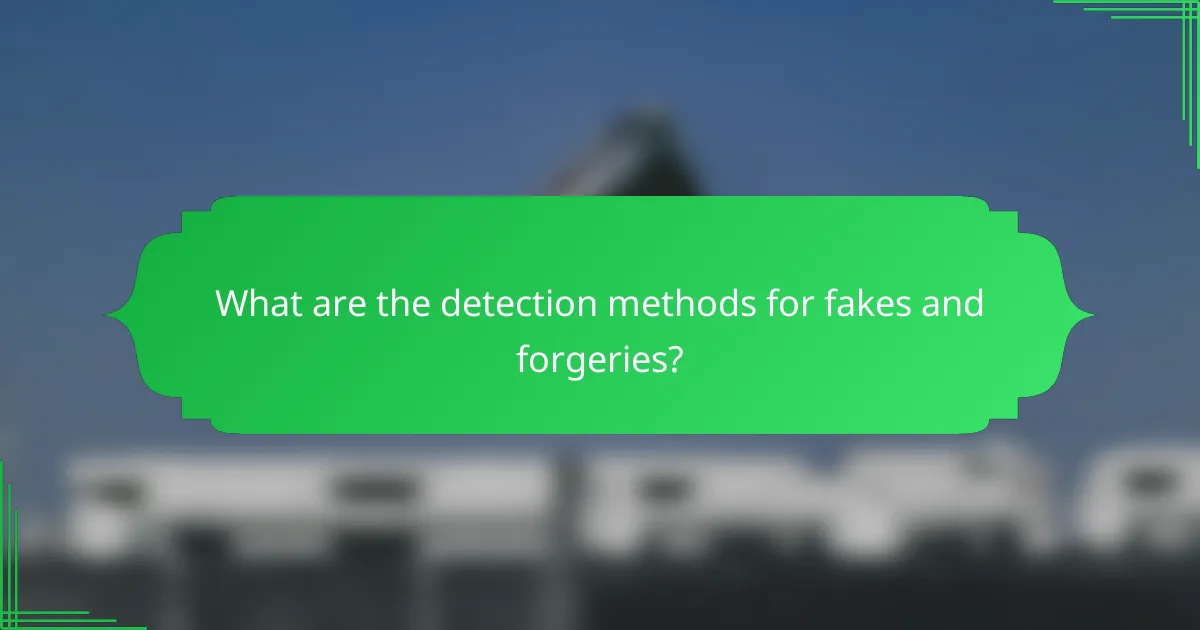
What are the detection methods for fakes and forgeries?
Detection methods for fakes and forgeries encompass a variety of techniques aimed at identifying counterfeit items across different markets. These methods range from simple visual inspections to advanced technological tools, each with its own strengths and limitations.
Visual inspection techniques
Visual inspection techniques involve examining an item for inconsistencies or anomalies that may indicate forgery. This can include checking for irregularities in design, color, or texture. For example, a genuine painting may have specific brush strokes that are absent in a counterfeit version.
Collectors and appraisers often use magnifying glasses or UV light to reveal hidden details. Familiarity with authentic items is crucial, as it allows for quicker identification of fakes through experience.
Technological tools for authentication
Technological tools for authentication utilize advanced equipment to analyze materials and detect counterfeits. Techniques such as infrared spectroscopy, X-ray fluorescence, and digital watermarking can provide detailed insights into an item’s composition and origin.
These tools are especially useful in art and luxury goods markets, where precision is vital. However, they often require specialized training and can be costly, making them less accessible for casual users.
Expert analysis and provenance research
Expert analysis and provenance research involve consulting specialists who can trace the history and ownership of an item. Experts often rely on documentation, previous sales records, and their own knowledge to authenticate pieces.
This method is particularly effective for high-value items, as establishing a clear provenance can significantly enhance an item’s credibility. However, it can be time-consuming and may not always yield definitive results.
Document verification processes
Document verification processes focus on validating the paperwork associated with an item, such as certificates of authenticity or appraisals. This involves checking for signs of tampering or forgery in the documents themselves.
Using standardized templates and security features can help identify fraudulent documents. It is essential to cross-reference documents with known databases to ensure their legitimacy.
Use of forensic science
The use of forensic science in detecting fakes and forgeries applies scientific methods to analyze materials and techniques used in the creation of an item. Techniques such as chemical analysis and imaging can uncover discrepancies that are not visible to the naked eye.
Forensic analysis is particularly valuable in fields like archaeology and historical artifact authentication, where understanding the material’s age and origin is crucial. However, this approach often requires significant resources and expertise, limiting its use to specialized cases.
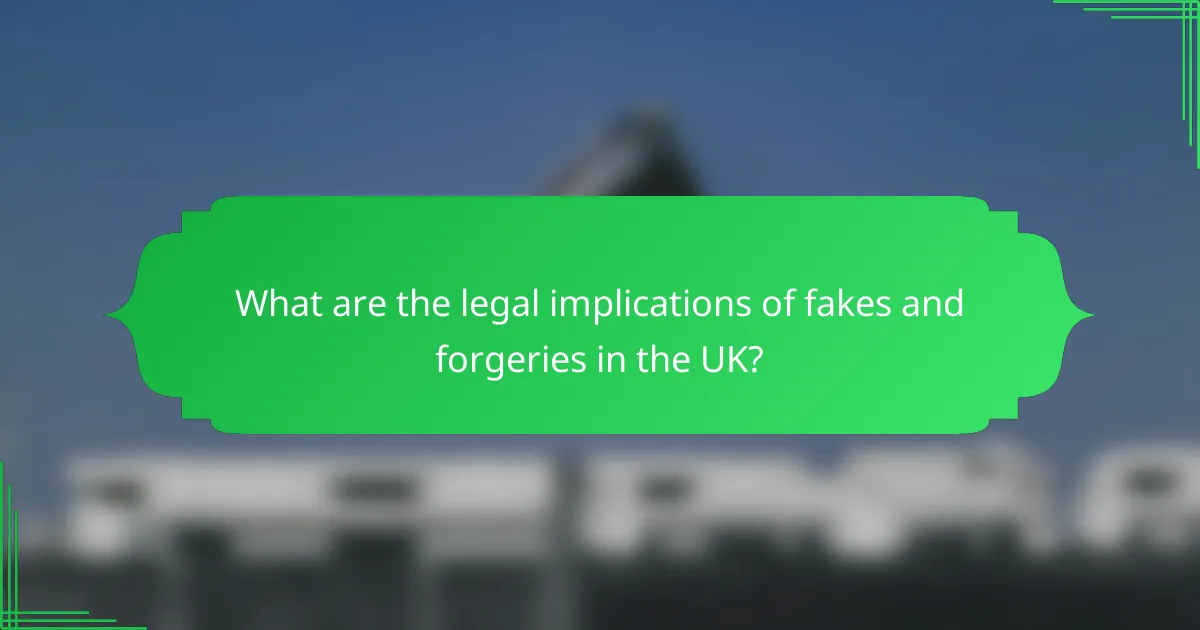
What are the legal implications of fakes and forgeries in the UK?
The legal implications of fakes and forgeries in the UK encompass various laws that protect intellectual property, consumer rights, and establish criminal liabilities. Engaging in the production or distribution of counterfeit goods can lead to significant legal consequences, including fines and imprisonment.
Intellectual property laws
Intellectual property laws in the UK, such as the Copyright, Designs and Patents Act, safeguard original works and inventions. These laws prohibit the unauthorized reproduction or distribution of protected materials, which includes counterfeit products. Violating these laws can lead to civil lawsuits and substantial financial penalties.
Businesses must ensure that their products do not infringe on existing trademarks or copyrights. Regular audits of product lines and supplier agreements can help mitigate risks associated with intellectual property violations.
Consumer protection regulations
Consumer protection regulations in the UK, including the Consumer Rights Act, aim to protect buyers from misleading practices and unsafe products. Selling counterfeit goods can be classified as a deceptive practice, resulting in legal action from consumers or regulatory bodies. Businesses found guilty may face fines and be required to compensate affected consumers.
To comply with these regulations, companies should implement clear labeling and marketing practices. Providing accurate product information and ensuring quality control can help avoid legal issues related to consumer protection.
Criminal liability for forgery
Under the Forgery and Counterfeiting Act, individuals involved in the creation or distribution of forged documents or counterfeit goods can face criminal charges. Penalties may include imprisonment and hefty fines, depending on the severity of the offense. Repeat offenders or those involved in organized crime face harsher penalties.
Businesses should establish strict compliance programs to prevent forgery-related activities. Training employees on the legal ramifications of forgery and implementing robust verification processes can significantly reduce the risk of criminal liability.

How do fakes and forgeries impact the market?
Fakes and forgeries significantly disrupt market dynamics by undermining the integrity of products and brands. They can lead to financial losses for companies and diminish consumer confidence, ultimately affecting overall market stability.
Effects on brand reputation
The presence of fakes and forgeries can severely damage a brand’s reputation. When consumers encounter counterfeit products, they may associate the negative experience with the legitimate brand, leading to long-term trust issues. High-profile cases often result in public relations crises that require extensive efforts to rebuild brand image.
Brands may respond by increasing marketing efforts or investing in anti-counterfeit technologies, which can divert resources from other critical areas. This shift can further strain a company’s reputation if not managed properly.
Market value fluctuations
Fakes and forgeries can cause significant fluctuations in market value, particularly for luxury goods and collectibles. When counterfeit items flood the market, they can drive down the perceived value of authentic products, leading to decreased sales and profitability.
Investors and collectors may become wary, causing volatility in pricing and demand. For example, a surge in counterfeit designer handbags can lead to a sharp decline in the resale value of genuine items, impacting both retailers and consumers.
Consumer trust erosion
Consumer trust is crucial for market stability, and the rise of fakes and forgeries can erode this trust. When buyers are unsure about the authenticity of products, they may hesitate to make purchases, leading to reduced sales across the board.
To combat this erosion, brands must enhance transparency and educate consumers about identifying genuine products. Implementing measures such as certification programs or using blockchain technology for verification can help restore trust and encourage informed purchasing decisions.
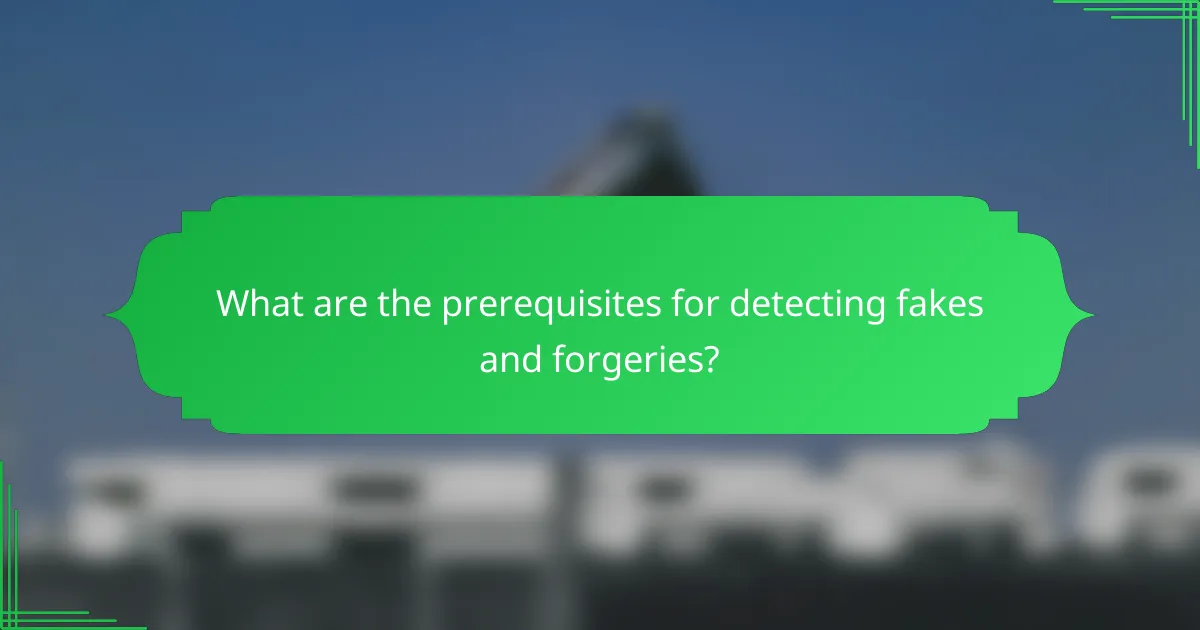
What are the prerequisites for detecting fakes and forgeries?
Detecting fakes and forgeries requires a solid foundation of knowledge and resources. Key prerequisites include understanding authentic products, having access to reliable databases, and possessing the necessary training and expertise.
Knowledge of authentic products
To effectively detect fakes and forgeries, one must have a thorough understanding of the characteristics that define authentic products. This includes knowledge of materials, manufacturing processes, and design elements specific to the genuine item.
For instance, a trained eye can spot differences in stitching, logos, and labels that may indicate a counterfeit. Familiarity with product specifications and quality standards is essential for accurate identification.
Access to reliable databases
Access to reliable databases is crucial for verifying the authenticity of products. These databases often contain detailed information about genuine items, including serial numbers, production dates, and authorized retailers.
Utilizing online resources or industry-specific databases can streamline the verification process. For example, databases that track luxury goods can help identify whether a product is genuine or counterfeit based on its unique identifiers.
Training and expertise requirements
Training and expertise are vital for anyone involved in detecting fakes and forgeries. This can include formal education in fields such as art history, design, or materials science, as well as practical experience in the industry.
Participating in workshops or certification programs can enhance skills in identifying counterfeits. Continuous learning about emerging trends and techniques in forgery is also important to stay ahead in this evolving field.
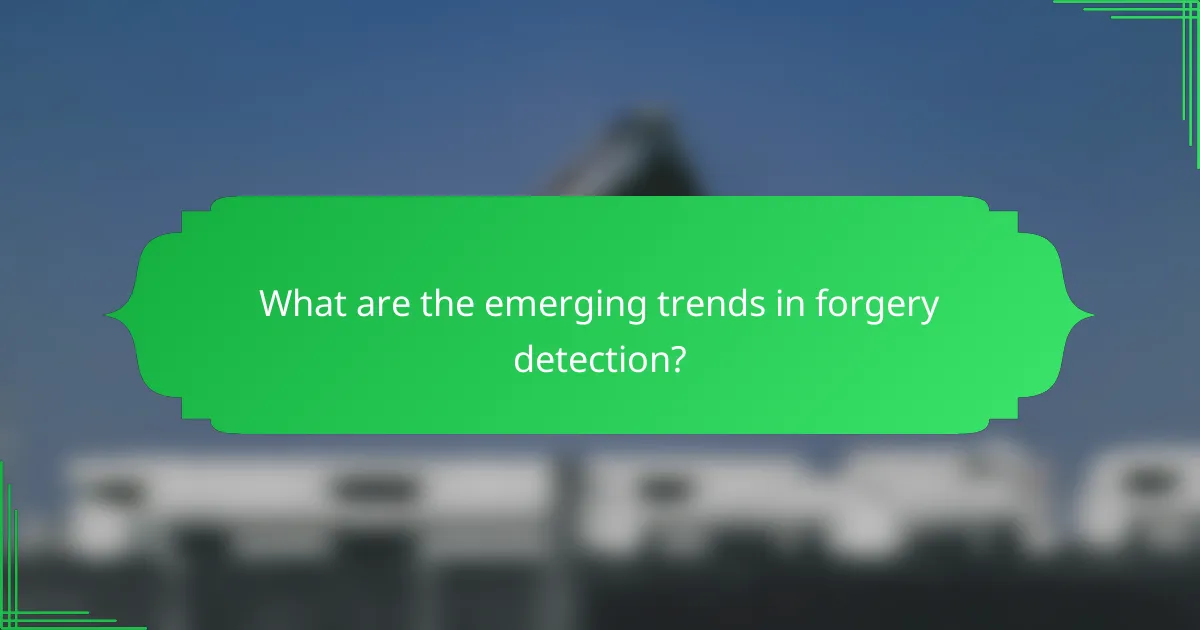
What are the emerging trends in forgery detection?
Emerging trends in forgery detection focus on advanced technologies that enhance accuracy and efficiency. Key developments include the use of artificial intelligence and blockchain technology, which are transforming how authenticity is verified in various markets.
AI and machine learning applications
AI and machine learning are increasingly utilized in forgery detection by analyzing patterns and anomalies in data. These technologies can process large datasets quickly, identifying subtle discrepancies that human inspectors might miss.
For example, machine learning algorithms can be trained on known authentic and counterfeit items, enabling them to recognize features that distinguish genuine products from fakes. This approach is particularly effective in sectors like art, luxury goods, and documents.
However, relying solely on AI can lead to false positives. It is crucial to combine these tools with human expertise for the best results, ensuring that the detection process is both efficient and reliable.
Blockchain for provenance tracking
Blockchain technology offers a secure method for tracking the provenance of items, making it difficult for counterfeit products to enter the market. By creating an immutable ledger, each transaction or ownership change can be recorded transparently, providing a clear history of an item’s authenticity.
For instance, luxury brands are increasingly adopting blockchain to verify the origins of their products, allowing consumers to trace the supply chain from production to purchase. This not only enhances trust but also deters counterfeiters.
Despite its advantages, implementing blockchain can be complex and costly. Businesses should weigh the benefits against the investment required, considering factors like scalability and user adoption to ensure effective use of this technology.
